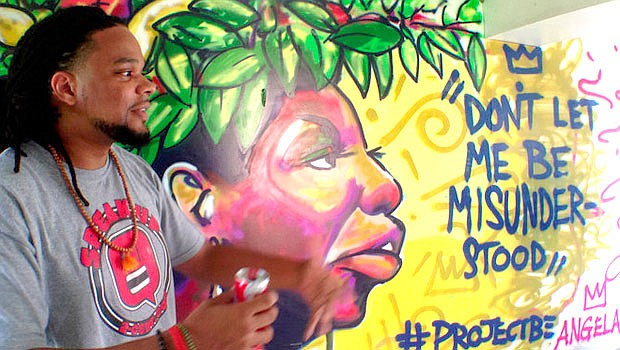- November 25, 2024
-
-
Loading

Loading

New Orleans-based street artist, Brandan Odums, will be in Sarasota this week for the Only Fifty art exhibit, which opens at 7 p.m. Friday, Sept. 12, at Fogartyville Community Media and Arts Center. The exhibit, which runs through Nov. 10, commemorates the 50th anniversary of the signing of the Civil Rights Act and will feature a collection of work by 50 local and international artists, who have offered works answering the question, "What does freedom mean to you?"
The opening will feature live dance and music performances, as well as demonstrations by Odums, who is known for his graffiti street-art style and focus on historical figures who were influential in the Civil Rights Movement.
We recently caught up with Odums to discuss post-Katrina New Orleans, his love for street art and what the Civil Rights Movement means to him.
When did you first begin creating art?
I've been creating art since as early as grade school. I went to art school and took art classes through middle school, so I was always creating art, but I wasn't doing it professionally until I was getting paid, which was a few years ago.
When did you realize it was something you wanted to pursue seriously?
I think when people are creative, at some point they acknowledge that what they do affects other people — it can alter their perspectives. I think when I realized that is when it really connected with me. It was something I was interested in: the power that it had. I think I realized that as early on as grade school that it was something that was bigger than me. People would tell me, "You're going to be an artist when you grow up." I had no idea what that would look like, but I took it and ran with it.
How did you get into street art?
I went to art school, and after graduation, I felt like I had accomplished my goal, so visual art kind of became a side thing. I started to get into filmmaking, and art was more like something I did to get away from my job. Two years ago, I really got into street art, and I fell in love with visual art all over again.
I think part of my frustration with art had always been the prestigious, gallery-type approach to creation. I didn't understand how that worked — how some people's art was so highly regarded, and other people's art wasn't even worthy of being part of the conversation. Street art counters that and goes beyond that mindset, and I fell in love with that.
How did you get exposed to that style of art? That had to be a change of pace after art school.
It started popping up in New Orleans after Hurricane Katrina. Street art had always caught my eye. Some of my friends and I became interested in urban exploration after Katrina, and we would go deep into an abandoned building and find these huge murals — murals nobody would ever see. So that took it to another level. It's about creating something for yourself and not an audience. It's the honesty of it.
I tried to get good at it, myself. You're painting on illegal or soon-to-be-demolished buildings, and people ask, "Why are you doing that? They're just going to tear that down." But that's what I love about it. It's about the moment. This art exists here, in this moment, for now, and maybe that's it. I get more out of that, personally. It really was breaking all the rules of what I learned there.
Tell me about your subject matter — there seems to be a pretty consistent theme.
I've always painted people I look up to, and I've always been interested in history and other people's stories. And if I spend hours painting and looking at someone's face, I feel like I get to know them a little more. The whole process is a sort of exploration for me. I try to see myself through the individual I'm painting. I want to understand from the past what it means to be where I am now.
Was the juxtaposition of your subject matter and your choice of canvas intentional?
I didn't notice it at first, but it eventually came up in conversation, and I became more conscious of it. You know, if you're painting a mural of someone who spent their life fighting for housing conditions on the wall of a building abandoned after Hurricane Katrina, it creates more of a statement. It's almost as if the subjects are speaking to the context. So that definitely became more of a focus to me as time went on.
Why was "Only Fifty" a good fit for you?
It made perfect sense. It's exciting to extend that type of work outside of New Orleans. Black history is American history, and I'm excited to see how the other artists incorporated that, too. One of the most beautiful things you can do as an artist is create with other people.
+ IF YOU GO:
Only Fifty — takes place at 7 p.m. Friday, Sept. 12, at the Fogartyville Community Media and Arts Center. $10.
photos courtesy of Brandan Odums